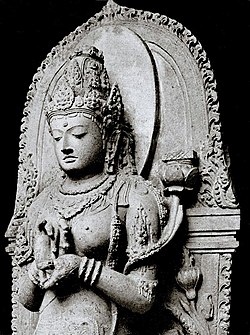Sailendra

The Sailendra Dynasty (also Cailendra Dynasty ) was prevalent in Java between about 760 and 860 . Their history is sketchy and fraught with deviating assumptions about their origins and their seizure of power.
The name Sailendra means "ruler of the mountains". Based on their title, there is a presumption that they were descendants of the ancient kings of Funan , which seems to be confirmed by the number of king names reproduced since that time (apparently nine Buddhist kings between the fall of Funan and the late 8th century).
The dynasty replaced the rule of the pirate king Sanjaya (around 732–746, in Mataram , south- central Java). The "ornament of the Sailendra", which is also given as "overcomer of the enemy heroes" was called Pananikarana or in another inscription Panangkaran (around 778). With his conversion to Buddhism he seems to have triggered the rise of the dynasty, but this is only one possible explanation. Princes who legitimized themselves through Sanjaya were vassals of the Sailendra in the following years and were displaced eastwards (middle of the 8th century).
The rule of the Sailendra was based on rice cultivation in Central Java, which at that time was the largest growing area in the region after Palembang . Little is known about their foreign policy, but they were also active in Sumatra and along the coast of Cambodia and Vietnam. King Indra attacked Champa here in 774 and 787 and shortly before 800 accepted the submission of the King of Chenla (also: Zhenla). The Sailendra cultivated good relationships with the likewise rather Buddhist Srivijaya , with whose rulers they were allied through a marriage alliance. Regular cultural contact with the Indian centers of Buddhism was given.
Around 824 the Sanjaya came back under their king Patapan (who is called again on an equal footing with the Sailendra): in an inscription from 832 only Patapan is mentioned as ruler of Java. Apparently Indra's son Samaratunga had been the last Sailendra to rule Java. His daughter and heir Pramoda Vardhani married Pikatan (around 838–851, son or other name of Patapan), a king of the Sanjaya line. As queen she continued to make foundations in Borobudur.
According to an inscription from Nalanda (India), Samaragravira (alias Samaratunga) had married the princess Tara from Srivijaya, apparently the daughter of the local king Dharmasetu (ruled around 775). His youngest son Balaputra came from the connection. Balaputra was expelled from Java and took over the government in Srivijaya around 850 because his mother was from there.
Known kings:
- approx. 752 Bhanu
- approx. 775 Vishnu (Dharma tunga)
- approx. 782–812 Indra (Sangrama Dhanamajaya)
- approx. 812-832 Taga (Samara tunga)
- approx. 832 Pramoda Vardhani (regent, married Pikatan)
- approx. 832–860 Balaputra-deva (fled to Sri Vijaya)
The architectural legacy of the Sailendra is Borobudur on the Kedu Plain. Since the rule of the Sailendra was limited to a kind of ritual supremacy (as was typical in ancient India), Borobudur served primarily to manifest their power. The (Shiva) temple in Prambanan , which Pikatan's house left behind around 900, may serve as a counterpart . The difference lies in the religion: the Sailendra were more likely to be followers of Mahayana Buddhism, their rivals of the Shiva cult and Hinduism.
Web links
- HB Sarkar: The Kings of Sri Sailam and the Foundation of the Saildendra Dynasty of Indonesia. In: Bijdragen tot de Taal-, Land- en Volkenkunde 141, No. 2/3, Leiden 1985, pp. 323–338